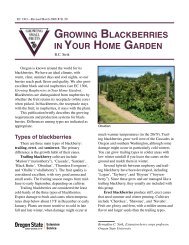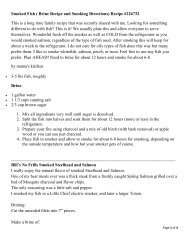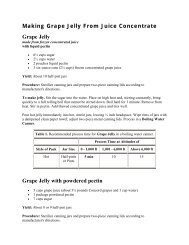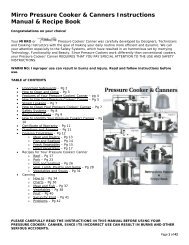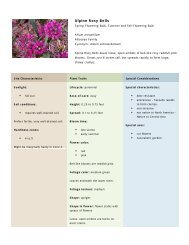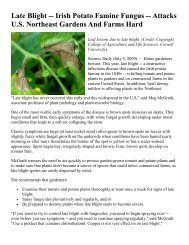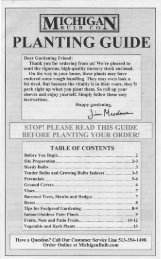Strawberry and Raspberry Pest Management in Wisconsin
Strawberry and Raspberry Pest Management in Wisconsin
Strawberry and Raspberry Pest Management in Wisconsin
You also want an ePaper? Increase the reach of your titles
YUMPU automatically turns print PDFs into web optimized ePapers that Google loves.
INTEGRATED PEST<br />
MANAGEMENT<br />
FEDERAL<br />
PESTICIDE-USE LAW<br />
WISCONSIN’S TRAINING AND<br />
CERTIFICATION PROGRAM<br />
<strong>Pest</strong> <strong>Management</strong> <strong>and</strong> <strong>Pest</strong>icides<br />
Controll<strong>in</strong>g a pest is only part of a total pest management program.<br />
<strong>Pest</strong> control is a corrective measure; you use pesticides or some other<br />
control method to reduce a damag<strong>in</strong>g (or potentially damag<strong>in</strong>g) pest<br />
population. <strong>Pest</strong> management, however, <strong>in</strong>cludes preventative<br />
measures as well.<br />
The primary goal of your pest management program is to ma<strong>in</strong>ta<strong>in</strong><br />
pest damage at an acceptable level. Eradication of pests is rarely<br />
possible <strong>and</strong> rarely feasible. In fact, our attempts at eradication may<br />
create more problems than they solve (pesticide resistance, secondary<br />
pest outbreaks, etc.). <strong>Pest</strong>icides are vital, effective tools for agriculture<br />
<strong>and</strong> for the production of our nation’s food <strong>and</strong> fiber, but they aren’t a<br />
cure-all for all of our pest problems. Rather, they must be viewed <strong>in</strong> the<br />
context of a total pest management program.<br />
Integrated <strong>Pest</strong> <strong>Management</strong> (IPM) is the coord<strong>in</strong>ated use of multiple<br />
pest control methods. By becom<strong>in</strong>g familiar with the crop, the pest, <strong>and</strong><br />
all available control tactics, you can develop <strong>and</strong> implement a sound<br />
IPM program that will help you apply pesticides only when necessary.<br />
When Congress amended the Federal Insecticide, Fungicide, <strong>and</strong><br />
Rodenticide Act (FIFRA) <strong>in</strong> 1972, it <strong>in</strong>cluded a m<strong>and</strong>ate for the<br />
Environmental Protection Agency (EPA) to evaluate all new <strong>and</strong> exist<strong>in</strong>g<br />
pesticide products for potential harm they may cause. It also made it<br />
illegal to use, except as provided by FIFRA, any pesticide <strong>in</strong> a manner<br />
<strong>in</strong>consistent with its label<strong>in</strong>g. Deviations from the label not recognized<br />
by FIFRA are a violation of the law.<br />
The Food Quality Protection Act (FQPA) of 1996 strengthens the system<br />
that regulates pesticide residues on food. Recogniz<strong>in</strong>g that pesticide<br />
residues are present <strong>in</strong> more sources than just food, the FQPA sets<br />
limits on the total exposure from residues found <strong>in</strong> food, dr<strong>in</strong>k<strong>in</strong>g<br />
water, <strong>and</strong> nondietary sources (such as household, l<strong>and</strong>scape, <strong>and</strong> pet<br />
uses). As a result, the more uses a particular pesticide has, the greater<br />
the chance its total exposure will be met <strong>and</strong>, thus, some or all of its<br />
uses will be canceled.<br />
If, dur<strong>in</strong>g the pesticide registration process, the EPA f<strong>in</strong>ds a product to<br />
generally cause unreasonable adverse effects on the environment,<br />
<strong>in</strong>clud<strong>in</strong>g <strong>in</strong>jury to the applicator, it will be classified as restricted-use.<br />
Because restricted-use products can be used only by certified<br />
applicators, the FIFRA amendments also called for each state to develop<br />
a program for tra<strong>in</strong><strong>in</strong>g <strong>and</strong> certify<strong>in</strong>g pesticide applicators. The<br />
certification program is designed to ensure that users of restricted-use<br />
products are properly qualified to h<strong>and</strong>le <strong>and</strong> apply these materials<br />
safely <strong>and</strong> efficiently. A current list of restricted-use pesticides<br />
registered for use <strong>in</strong> Wiscons<strong>in</strong> may be downloaded from the <strong>Pest</strong>icide<br />
Applicator Tra<strong>in</strong><strong>in</strong>g web site (ipcm.wisc.edu/pat).<br />
In Wiscons<strong>in</strong>, responsibility for tra<strong>in</strong><strong>in</strong>g lies with the University of<br />
Wiscons<strong>in</strong>-Extension’s <strong>Pest</strong>icide Applicator Tra<strong>in</strong><strong>in</strong>g (PAT) program,<br />
while actual certification is the responsibility of the Wiscons<strong>in</strong><br />
Department of Agriculture, Trade, <strong>and</strong> Consumer Protection (WDATCP).<br />
The Wiscons<strong>in</strong> <strong>Pest</strong>icide Law requires that all commercial applicators for<br />
hire participate <strong>in</strong> the tra<strong>in</strong><strong>in</strong>g <strong>and</strong> certification process if they <strong>in</strong>tend to<br />
use any pesticide <strong>in</strong> the state of Wiscons<strong>in</strong>, whether or not it is<br />
1




